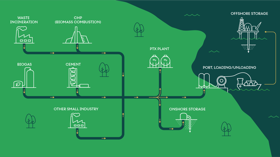Carbon-what?!
Capture CO2 and send it back underground, or use it to make the fuels of the future. That, in short, is what CCUS – or Carbon Capture, Utilization, and Storage – is all about.
Carbon Capture and Storage (CCS) is a technology with the potential to reduce greenhouse gas emissions in the atmosphere and combat climate change.
A broad political majority in the Danish Parliament has decided that carbon capture and storage should be an important element in achieving Denmark’s climate goals. By 2030, Denmark must have reduced its greenhouse gas emissions by 70 percent compared to 1990 and be climate neutral by 2045 at the latest.
In the long term, CO2 should not be pumped underground, as it also has potential as a raw material in the production of so-called e-fuels, a sustainable alternative to fossil fuels. In this way, CCS becomes CCU – Carbon Capture and Utilization.

Questions & Answers about CCUS
How does CCUS work?
CCUS works by capturing CO2 from the flue gases of combined heat and power plants, waste incineration plants, and energy-intensive production companies, as well as from biogas production, and storing it deep underground or using it to produce green fuels.
The most commonly used technology for capturing CO2 is ‘washing’ CO2 from the flue gases in a closed loop. The process involves passing the CO2-containing flue gas through a container where an amine – a chemical liquid – absorbs the CO2 upon contact. The CO2-laden amine is then pumped into another container where it is heated until the CO2 boils out of the amine, which can then be reused without waste. This technology typically allows for the capture of 90 percent of the CO2 in the flue gas, which would otherwise have been emitted into the atmosphere.
The captured CO2 can then be transported to an underground storage site or used in a facility that produces green fuels.
Is it a new technology?
CCS technology has been used since the 1970s. Since 1996, CO2 capture and storage have been used in Norway to reduce CO2 emissions from gas extraction in the North Sea. According to the Global CCS Institute’s 2023 status report, there are currently 41 CCS facilities in operation worldwide, 25 facilities – several of which are in Denmark – under construction, and 325 facilities under development.
How much CO2 can we capture in Denmark?
It is difficult to say exactly how much CO2 can be captured in Denmark in the long term. It depends on the development of the green transition in both the industrial and energy sectors. The Danish Energy Agency estimates that the capture potential in 2040 from Danish point sources is approximately 5.4-10.8 million tons per year, of which approximately 3.5-6 million tons come from biogenic sources such as biomass combustion and biogas production.
For comparison, Denmark’s total greenhouse gas emissions in 2022 were 44 million tons of CO2 equivalents.
Most of the capture potential in 2040 comes from point sources concentrated in clusters around Copenhagen, Aarhus, Aalborg, and Southern Jutland. A point source is a specific location/facility from which CO2 is emitted into the atmosphere.
How much CO2 can we store in Denmark?
CO2 storage – the ‘S’ in CCS – takes place in geologically suitable underground structures 1,000-2,500 meters below the earth’s surface, and it can occur both onshore and offshore or nearshore, where the latter is close enough to land to make pipeline construction economically viable.
According to the Geological Survey of Denmark and Greenland (GEUS), the Danish underground has significant potential for CO2 storage. GEUS estimates that between 12 and 22 billion tons of CO2 can be stored, which is between 400 and 700 times more than Denmark’s total annual CO2 emissions at current levels. So far, GEUS has identified and designated eight suitable sites in Denmark – five on land and three offshore.
Can CO2 be used for anything?
Storing CO2 is a method to reduce CO2 emissions in the short term. In the long term, CO2 should not be pumped underground – at least not all of it – as it also has potential as a raw material in the production of e-fuels – green fuels – as an alternative to fossil fuels. This is known as Carbon Capture and Utilization (CCU).
E-fuels are produced in Power-to-X plants, which split water into oxygen and hydrogen using electricity from wind or solar energy. Hydrogen can be used as fuel for industry and heavy transport, but when carbon from CO2 is added, it can also become e-methane or e-methanol. E-methane can be used for heating, like biogas, and e-methanol can be used as fuel for ships and planes. Power-to-X production is very energy-intensive, so from both a sustainability and economic perspective, it is crucial that the electricity comes from renewable energy sources. Additionally, the processes release a lot of heat, which has potential as an energy source for district heating.
How should CO2 be transported?
Whether CO2 is to be stored onshore, nearshore, or offshore, or used in the production of e-fuels, it must be transported over short or long distances. This can be done by truck, ship, train, and/or pipeline.
As a distributor, Evida believes that transport should be carried out using the most appropriate mode of transport for the given route, considering sustainability, economy, impact on citizens’ daily lives, and safety.
Which mode of transport has the lowest CO2 emissions?
The consulting engineering company COWI has examined how many kg of CO2 equivalents three types of transport emit per ton of CO2 transported. Land pipeline transport has the lowest emissions, followed by truck transport, and finally ship transport, which has significantly higher emissions than the other two.
The study also looks at what causes the emissions. Not surprisingly, the construction of the pipeline, including pipes and excavation work, accounts for a relatively large share of its emissions, but its operation has lower emissions compared to the fuel used by trucks and ships to transport the CO2.
The same point applies to economics. It is relatively expensive to establish the pipeline infrastructure, but once it is in place and transporting optimal volumes of CO2, it does so more cheaply than trucks and ships. Therefore, a scalable CO2 pipeline infrastructure is the most cost-effective solution.
The impact on citizens’ daily lives is similar: the excavation of a CO2 pipeline affects people’s daily lives while the work is ongoing. After that, it lies underground and does not cause disruption. This is different from the heavy traffic that CO2 transport by truck can cause.


